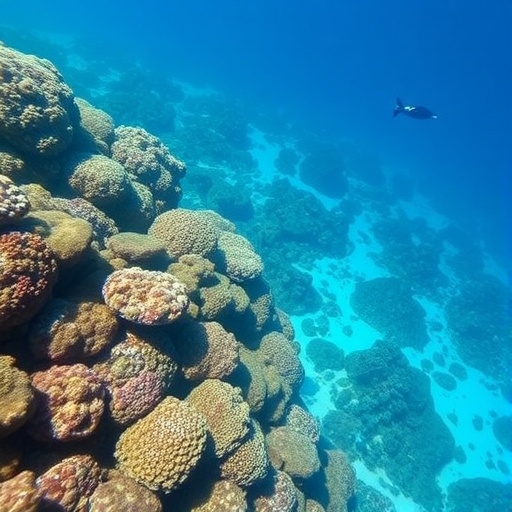Recent studies have shed light on the intricate relationship between corals and their ecological environments, revealing a fascinating mechanism known as ecological niche construction. This process refers to the ways in which organisms, particularly corals, actively modify their environment, thereby creating new habitats for future generations. The research conducted by Brambilla and colleagues offers a comprehensive examination of coral settlement patterns concerning structural complexity in their surrounding habitat.
Coral reefs have long been renowned for their biodiversity and ecological importance. However, the complexities underlying coral development are often overlooked. Brambilla et al. delve into how increased structural complexity influences not only the health of existing coral populations but also encourages new coral settlements. By constructing environments that enhance their own growth, corals engage in a unique form of self-facilitation that impacts the ecological dynamics of reef systems.
The study meticulously illustrates that corals create three-dimensional structures that serve as breeding grounds for various marine species. These structures, built primarily from calcium carbonate, serve multiple purposes: they provide shelter, increase habitat diversity, and ultimately enhance the settlement potential for other corals and marine organisms. With this mechanistic understanding, researchers highlight the crucial role structural complexity plays in maintaining healthy coral populations.
In the context of global environmental changes, the implications of this research are profound. Coral reefs face numerous threats, from climate change to ocean acidification, which can significantly alter their structural integrity. The findings from Brambilla et al. suggest that preserving and enhancing structural complexity in reef systems could be a critical strategy for reef conservation efforts. By fostering environments where corals can thrive and reproduce, researchers can develop more effective methods to combat the decline of these vital ecosystems.
Importantly, the research indicates a positive feedback loop: as corals construct their environments, they not only facilitate their own success but also contribute to the overall resilience of the reef ecosystem. This points to a fundamental principle in ecology—organisms are not merely passive residents of their environments but play active roles in shaping them. This dynamic interplay emphasizes the need for ecosystem-based management approaches that recognize and prioritize these interactions.
Moreover, the role of structural complexity extends beyond just coral to include a diverse array of marine life. According to the findings, increased complexity in coral structures supports a broader range of species, enhancing biodiversity and stabilizing the overall ecosystem. This interconnectedness is vital for establishing resilient marine environments that can withstand the pressures of climate change and human activity.
Furthermore, this research employs rigorous methodologies, including field studies and controlled experiments, to substantiate its claims. By quantitatively assessing the rates of coral settlement in relation to habitat complexity, Brambilla et al. successfully link empirical data with theoretical models. This robust approach lends credibility to their findings and underscores the importance of empirical research in ecology.
The study also raises critical questions about future environments and the potential for engineered habitats that could support coral resilience. As artificial structures are integrated into marine environments, researchers must evaluate how these constructions can mimic natural complexity and facilitate coral growth. This could extend into various applications, from coastal management to biotechnology, as solutions for coral conservation become increasingly necessary.
In conclusion, this comprehensive investigation into coral ecological niche construction offers a vital perspective on the intricate relationships within marine ecosystems. By emphasizing how corals construct and influence their habitats, the research highlights their active role in sustaining and enhancing coral reef health. These findings are not only significant for coral conservation efforts but also contribute to broader discussions about ecological resilience and adaptive management in the face of environmental changes.
As awareness of coral reefs’ plight continues to grow, studies like those conducted by Brambilla et al. become not only relevant but essential. Their investigation illustrates that coral reefs are dynamic systems with the potential for self-enhancement, laying the groundwork for future conservation strategies that prioritize structural complexities. Scholars, policymakers, and conservationists alike can glean crucial insights from this research, propelling forward a more sustainable future for coral reefs worldwide.
The repercussions of this research extend beyond scientific discourse; they underscore a collective responsibility to protect and restore coral ecosystems. Given the rapid decline of reefs globally, proactive measures grounded in scientific evidence are paramount. As the urgent need for coral conservation mounts, the understanding that corals are not merely passive beings in their environment but pivotal architects could inspire innovative approaches to safeguard these ecosystems.
The findings of Brambilla et al. serve as a call to arms for the scientific community and society at large. Insight into the mechanisms of ecological niche construction can fuel new initiatives aimed at restoring coral habitats and promoting sustainable practices that benefit both marine life and human communities. The future of coral reefs may well depend on our ability to foster these environments and implement solutions that uphold the intricate balance of marine ecosystems.
In summary, as we continue to unravel the complexities of coral ecology, the insights gained from this research will undoubtedly shape both scientific understanding and conservation strategies. By recognizing the role of corals as active constructors of their environments, we can direct our efforts more effectively to ensure the survival of these irreplaceable ecosystems.
Subject of Research: Coral ecological niche construction and its impact on coral settlement patterns.
Article Title: Coral ecological niche construction: coral settlement increases along a coral-built structural complexity gradient.
Article References:
Brambilla, V., Baird, A.H., Barbosa, M. et al. Coral ecological niche construction: coral settlement increases along a coral-built structural complexity gradient. Coral Reefs (2025). https://doi.org/10.1007/s00338-025-02776-w
Image Credits: AI Generated
DOI: https://doi.org/10.1007/s00338-025-02776-w
Keywords: Coral, ecological niche construction, coral settlement, structural complexity, coral reefs, marine biodiversity, conservation strategies.




